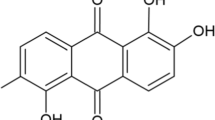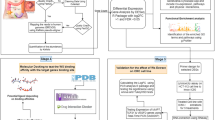Abstract
All-trans-retinoic acid (ATRA) is the main biologically active metabolite of retinol (vitamin A) that is required for the regulation of processes such as embryogenesis, tissue differentiation, proliferation, and others. Multiple alcohol, retinol, and retinaldehyde dehydrogenases (ADHs, RDHs, and RALDHs), as well as aldo-keto reductases (AKRs) catalyze the biosynthesis of retinoic acid in humans. For many normal and neoplastic tissues, the key ATRA-synthesizing enzymes remain unknown. We identified ATRA-generating genes that are expressed in normal and malignant gastric tissues using the transcriptomic database analysis. Quantitative changes in the expression levels of these genes in gastric cancer were determined by semi-quantitative RT-PCR and real-time PCR. Significant decreases in the mRNA levels of genes that encode the enzymes that catalyze the reversible oxidation/reduction of retinol and retinaldehyde (ADH4, ADH1B, ADH1C, RDHL, AKR1B10, AKR1B1, and RDH12), as well as the oxidation of retinaldehyde (RALDH1) were revealed in most tumor samples. A sharp reduction in the expression levels of genes encoding the key enzymes that convert retinol and retinaldehyde to retinoic acid could lead to a significant decrease in the content of ATRA, the transcriptional regulator of many genes, which can in turn lead to the dysregulation of cell proliferation/differentiation and initiate the development of cancer.
Similar content being viewed by others
Abbreviations
- ADH:
-
alcohol dehydrogenase
- AKR:
-
aldo-keto reductase
- ATRA:
-
all-trans-retinoic acid
- CRBP1:
-
Cellular retinol-binding protein-1
- CYP26A1:
-
B1, C1 are proteins of CYP26 family (cytochrome P450-dependent monooxigenases)
- RALDH:
-
retinaldehyde dehydrogenase
- RDH:
-
retinol dehydrogenase
- RefExA:
-
Reference database for gene Expression Analysis
- PCR:
-
polymerase chain reaction
- RT-PCR:
-
reverse transcription PCR
References
Blomhoff R., Blomhoff H.K. 2006. Overview of retinoid metabolism and function. J. Neurobiol. 66, 606–630.
Harrison E.H. 2012. Mechanisms involved in the intestinal absorption of dietary vitamin A and provitamin A carotenoids. Biochim. Biophys. Acta. 1821, 70–77.
Napoli J.L. 2012. Physiological insights into all-trans-retinoic acid biosynthesis. Biochim. Biophys. Acta. 1821, 152–167.
Kumar S., Sandell L.L., Trainor P.A., Koentgen F., Duester G. 2012. Alcohol and aldehyde dehydrogenases: Retinoid metabolic effects in mouse knockout models. Biochim. Biophys. Acta. 1821, 198–205.
Duester G., Farrés J., Felder M.R., Holmes R.S., Höög J.O., Parés X., Plapp B.V., Yin S.J., Jörnvall H. 1999. Recommended nomenclature for the vertebrate alcohol dehydrogenase gene family. Biochem. Pharmacol. 58, 389–395.
Estonius M., Svensson S., Höög J.-O. 1996. Alcohol dehydrogenase in human tissues: Localization of transcripts coding for five classes of the enzyme. FEBS Lett. 397, 338–342.
Molotkov A., Deltour L., Foglio M.H., Cuenca A.E., Duester G. 2002. Distinct retinoid metabolic functions for alcohol dehydrogenase genes Adh1 and Adh4 in protection against vitamin A toxicity or deficiency revealed in double null mutant mice. J. Biol. Chem. 277, 13804–13811.
Molotkov A., Fan X., Deltour L., Foglio M.H., Martras S., Farrés J., Parés X., Duester G. 2002. Stimulation of retinoic acid production and growth by ubiquitously expressed alcohol dehydrogenase Adh3. Proc. Natl. Acad. Sci. U. S. A. 99, 5337–5342.
Gallego O., Belyaeva O.V., Porté S., Ruiz F.X., Stetsenko A.V., Shabrova E.V., Kostereva N.V., Farrés J., Parés X., Kedishvili N.Y. 2006. Comparative functional analysis of human medium-chain dehydrogenases, short-chain dehydrogenases/reductases, and aldo-keto reductases with retinoids. Biochem. J. 399, 101–109.
Parés X., Farrés J., Kedishvili N., Duester G. 2008. Medium- and short-chain dehydrogenase/reductase gene and protein families: Medium-chain and short-chain dehydrogenases/reductases in retinoid metabolism. Cell. Mol. Life Sci. 65, 3936–3949.
Lidén M., Eriksson U. 2006. Understanding retinol metabolism: Structure and function of retinol dehydrogenases. J. Biol. Chem. 281, 13001–13004.
Kallberg Y., Oppermann U., Persson B. 2010. Classification of the short-chain dehydrogenase/reductase superfamily using hidden Markov models. FEBS J. 277, 2375–2386.
Belyaeva O.V., Johnson M.P., Kedishvili N.Y. 2008. Kinetic analysis of human enzyme RDH10 defines the characteristics of a physiologically relevant retinol dehydrogenase. J. Biol. Chem. 28, 20299–20308.
Belyaeva O.V., Korkina O.V., Stetsenko A.V., Kim T., Nelson P.S., Kedishvili N.Y. 2005. Biochemical properties of purified human retinol dehydrogenase 12 (RDH12): Catalytic efficiency toward retinoids and C9 aldehydes and effects of cellular retinol-binding protein type I (CRBPI) and cellular retinaldehyde-binding protein (CRALBP) on the oxidation and reduction of retinoids. Biochemistry. 44, 7035–7047.
Crosas B., Hyndman D.J., Gallego O., Martras S., Parés X., Flynn T.G., Farrés J. 2003. Human aldose reductase and human small intestine aldose reductase are efficient retinal reductases: Consequences for retinoid metabolism. Biochem. J. 373, 973–979.
Ross A.C., Zolfaghari R. 2011. Cytochrome P450s in the regulation of cellular retinoic acid metabolism. Annu. Rev. Nutr. 31, 65–87.
Jette C., Peterson P.W., Sandoval I.T., Manos E.J., Hadley E., Ireland C.M., Jones D.A. 2004. The tumor suppressor adenomatous polyposis coli and caudal related homeodomain protein regulate expression of retinol dehydrogenase L. J. Biol. Chem. 279, 34397–34405.
Pasquali D., Thaller C., Eichele G. 1996. Abnormal level of retinoic acid in prostate cancer tissues. J. Clin. Endocrinol. Metab. 81, 2186–2191.
Mira Y.L.R., Zheng W.L., Kuppumbatti Y.S., Rexer B., Jing Y., Ong D.E. 2000. Retinol conversion to retinoic acid is impaired in breast cancer cell lines relative to normal cells. J. Cell Physiol. 185, 302–309.
Williams S.J., Cvetkovic D., Hamilton T.C. 2009. Vitamin A metabolism is impaired in human ovarian cancer. Gynecol. Oncol. 112, 637–645.
Matsumoto M., Yokoyama H., Suzuki H., Shiraishi-Yokoyama H., Hibi T. 2005. Retinoic acid formation from retinol in the human gastric mucosa: Role of class IV alcohol dehydrogenase and its relevance to morphological changes. Am. J. Physiol. Gastrointest. Liver Physiol. 289, G429–433.
Jemal A., Bray F., Center M.M., Ferlay J., Ward E., Forman D. 2011. Global cancer statistics. CA Cancer J. Clin. 61, 69–90.
Davydov M.I., Aksel’ E.M. 2011. Morbidity and mortality due to malignant neoplasms in Russia and CIS countries in 2009. Vestn. Ross. Onkol. Hauch. Tsentra im. N.N. Blokhina Ross. Akad. Med. Sci., 22, Suppl. 1, 54–123.
Yokoyama H., Matsumoto M., Shiraishi H., Miyagi M., Kato And S., Ishii H. 2001. Nicotinamide adenine dinucleotide-dependent retinoic acid formation from retinol in the human gastric mucosa: Inhibition by ethanol, acetaldehyde, and H2 blockers. Alcohol. Clin. Exp. Res. 25, 24S–28S.
Persson C., Sasazuki S., Inoue M., Kurahashi N., Iwasaki M., Miura T., Ye W., Tsugane S.; JPHC Study Group. 2008. Plasma levels of carotenoids, retinol and tocopherol and the risk of gastric cancer in Japan: A nested case-control study. Carcinogenesis. 29, 1042–1048.
Larsson S.C., Bergkvist L., Näslund I., Rutegård J., Wolk A. 2007. Vitamin A, retinol, and carotenoids and the risk of gastric cancer: A prospective cohort study. Am. J. Clin. Nutr. 85, 497–503
Rhodes D.R., Yu J., Shanker K., Deshpande N., Varambally R., Ghosh D., Barrette T., Pandey A., Chinnaiyan A.M. 2004. ONCOMINE: A cancer microarray database and integrated data-mining platform. Neoplasia. 6, 1–6.
Manzeniuk O.Yu., Malakho S.G., Pekhov V.M., Kosorukova I.S., Poltaraus A.B. 2006. Characterization of the universal Russian reagent sets for real-time PCR and its application to molecular oncodiagnosis. Mol. Biol. (Moscow). 40, 305–311.
Zhang J.P., Chen X.Y., Li J.S. 2007. Effects of all-trans-retinoic on human gastric cancer cells BGC-823. J. Dig. Dis. 8, 29–34.
Fukumoto S., Yamauchi N., Moriguchi H., Hippo Y., Watanabe A., Shibahara J., Taniguchi H., Ishikawa S., Ito H., Yamamoto S., Iwanari H., Hironaka M., Ishikawa Y., Niki T., Sohara Y., Kodama T., Nishimura M., Fukayama M., Dosaka-Akita H., Aburatani H. 2005. Overexpression of the aldo-keto reductase family protein AKR1B10 is highly correlated with smokers’ non-small cell lung carcinomas. Clin. Cancer Res. 11, 1776–1785.
Leclerc J., Courcot-Ngoubo Ngangue E., Cauffiez C., Allorge D., Pottier N., Lafitte J.J., Debaert M., Jaillard S., Broly F., Lo-Guidice J.M. 2011. Xenobiotic metabolism and disposition in human lung: Transcript profiling in non-tumoral and tumoral tissues. Biochimie. 93, 1012–1027.
Chiang C.P., Jao S.W., Lee S.P., Chen P.C., Chung C.C., Lee S.L., Nieh S., Yin S.J. 2012. Expression pattern, ethanol-metabolizing activities, and cellular localization of alcohol and aldehyde dehydrogenases in human large bowel: Association of the functional polymorphisms of ADH and ALDH genes with hemorrhoids and colorectal cancer. Alcohol. 46, 37–49.
Zaitseva M., Vollenhoven B.J., Rogers P.A. 2007. Retinoic acid pathway genes show significantly altered expression in uterine fibroids when compared with normal myometrium. Mol. Hum. Reprod. 13, 577–585.
Ashla A.A., Hoshikawa Y., Tsuchiya H., Hashiguchi K., Enjoji M., Nakamuta M., Taketomi A., Maehara Y., Shomori K., Kurimasa A., Hisatome I., Ito H., Shiota G. 2010. Genetic analysis of expression profile involved in retinoid metabolism in non-alcoholic fatty liver disease. Hepatol. Res. 40, 594–604.
O’Shaughnessy P.J., Abel M., Charlton H.M., Hu B., Johnston H., Baker P.J. 2007. Altered expression of genes involved in regulation of vitamin A metabolism, solute transportation, and cytoskeletal function in the androgen-insensitive tfm mouse testis. Endocrinology. 148, 2914–2924.
Collins M.D., Eckhoff C., Chahoud I., Bochert G., Nau H. 1992. 4-Methylpyrazole partially ameliorated the teratogenicity of retinol and reduced the metabolic formation of all-trans-retinoic acid in the mouse. Arch. Toxicol. 66, 652–659.
Chetyrkin S.V., Belyaeva O.V., Gough W.H., Kedishvili N.Y. 2001. Characterization of a novel type of human microsomal 3α-hydroxysteroid dehydrogenase: Unique tissue distribution and catalytic properties. J. Biol. Chem. 276, 22278–22286.
Wang J., Chai X., Eriksson U., Napoli J.L. 1999. Activity of human 11-cis-retinol dehydrogenase (Rdh5) with steroids and retinoids and expression of its mRNA in extra-ocular human tissue. Biochem. J. 338, 23–27.
Chase J.R., Poolman M.G., Fell D.A. 2009. Contribution of NADH increases to ethanol’s inhibition of retinol oxidation by human ADH isoforms. Alcohol. Clin. Exp. Res. 33, 571–580.
Yin S.J., Chou C.F., Lai C.L., Lee S.L., Han C.L. 2003. Human class IV alcohol dehydrogenase: Kinetic mechanism, functional roles and medical relevance. Chem. Biol. Interact. 143/144, 219–227.
Molotkov A., Duester G. 2003. Genetic evidence that retinaldehyde dehydrogenase Raldh1 (Aldh1a1) functions downstream of alcohol dehydrogenase Adh1 in metabolism of retinol to retinoic acid. J. Biol. Chem. 278, 36085–36090.
Mashkova T.D., Oparina N.Yu., Zinov’eva O.L., Kropotova E.S., Dubovaya V.I., Poltaraus A.B., Fridman M.V., Kopantsev E.P., Vinogradova T.V., Zinov’eva M.V., Laktionov K.K., Kasymova O.T., Zborovskaya I.B., Sverdlov E.D., Kisselev L.L. 2006. Transcription of TIMP3, DAPK1, and AKR1B10 in squamous-cell lung cancer. Mol. Biol. (Moscow). 40, 945–951.
Scuric Z., Stain S.C., Anderson W.F., Hwang J.J. 1998. New member of aldose reductase family proteins over-expressed in human hepatocellular carcinoma. Hepatology. 27, 943–950.
Kropotova E.S., Tychko R.A., Zinov’eva O.L., Zyryanova A.F., Khankin S.L., Cherkes V.L., Aliev V.A., Beresten S.F., Oparina N.Yu., Mashkova T.D. 2010. Downregulation of AKR1B10 expression in colorectal cancer. Mol. Biol. (Moscow). 44, 216–222.
Martin H.J., Maser E. 2009. Role of human aldoketoreductase AKR1B10 in the protection against toxic aldehydes. Chem. Biol. Interact. 178, 145–150.
Westerlund M., Belin A.C., Felder M.R., Olson L., Galter D. 2007. High and complementary expression patterns of alcohol and aldehyde dehydrogenases in the gastrointestinal tract: implications for Parkinson’s disease. FEBS J. 274, 1212–1223.
Roberts E.S., Vaz A.D.N., Coon M.J. 1992. Role of isozymes of rabbit microsomal cytochrome P-450 in the metabolism of retinoic acid, retinol, and retinal. Mol. Pharmacol. 41, 427–433.
Tang X.H., Gudas L.J. 2011. Retinoids, retinoic acid receptors, and cancer. Annu. Rev. Pathol. 6, 345–364.
Li J., Ng E.K., Ng Y.P., Wong C.Y., Yu J., Jin H., Cheng V.Y., Go M.Y., Cheung P.K., Ebert M.P., Tong J., To K.F., Chan F.K., Sung J.J., Ip N.Y., Leung W.K. 2009. Identification of retinoic acid-regulated nuclear matrix-associated protein as a novel regulator of gastric cancer. Br. J. Cancer. 101, 691–698.
Hu K.W., Chen F.H., Ge J.F., Cao L.Y., Li H. 2012. Retinoid receptors in gastric cancer: Expression and influence on prognosis. Asian Pac. J. Cancer Prev. 13, 1809–1817.
Jiang S.Y., Shen S.R., Shyu R.Y., Yu J.C., Harn H.J., Yeh M.Y., Lee M.M., Chang Y.C. 1999. Expression of nuclear retinoid receptors in normal, premalignant and malignant gastric tissues determined by in situ hybridization. Br. J. Cancer. 80, 206–214.
Author information
Authors and Affiliations
Corresponding author
Additional information
Original Russian Text © E.S. Kropotova, O.L. Zinov’eva, A.F. Zyryanova, E.L. Choinzonov, S.G. Afanas’ev, N.V. Cherdyntseva, S.F. Beresten, N.Yu. Oparina, T.D. Mashkova, 2013, published in Molekulyarnaya Biologiya, 2013, Vol. 47, No. 2, pp. 317–330.
Rights and permissions
About this article
Cite this article
Kropotova, E.S., Zinov’eva, O.L., Zyryanova, A.F. et al. Expression of genes involved in retinoic acid biosynthesis in human gastric cancer. Mol Biol 47, 280–292 (2013). https://doi.org/10.1134/S0026893313020076
Received:
Accepted:
Published:
Issue Date:
DOI: https://doi.org/10.1134/S0026893313020076




